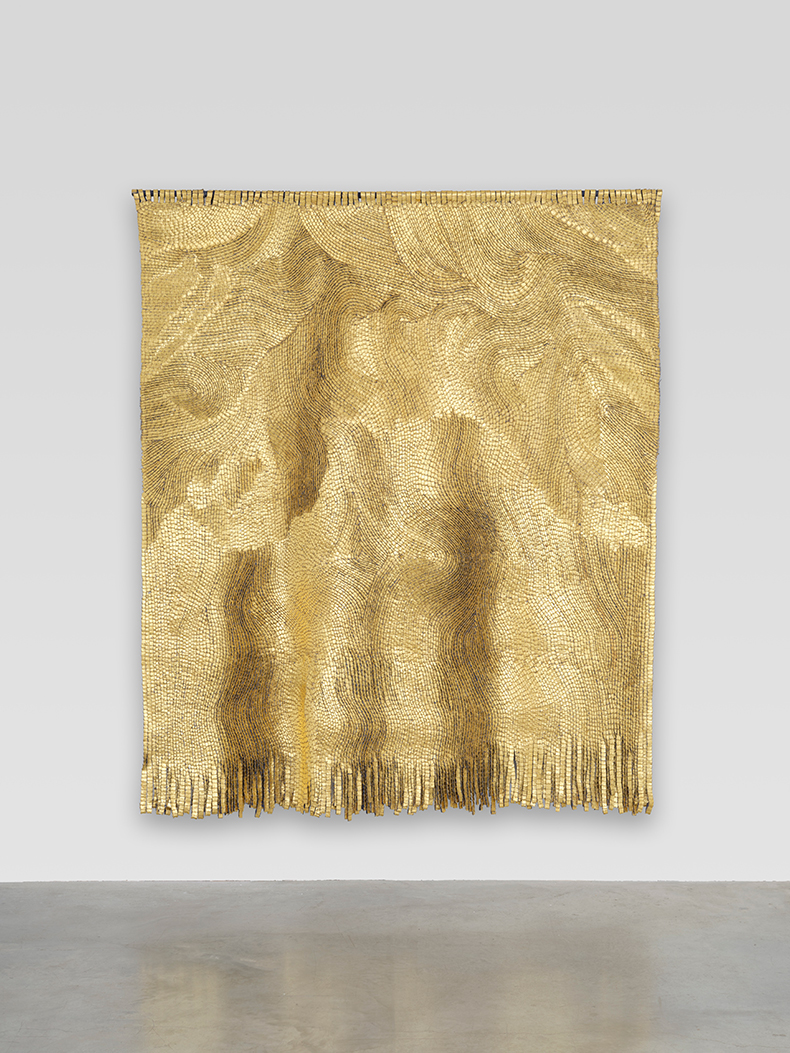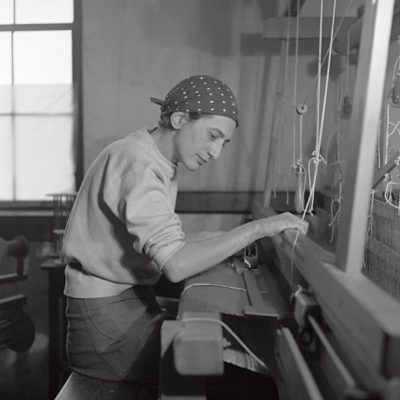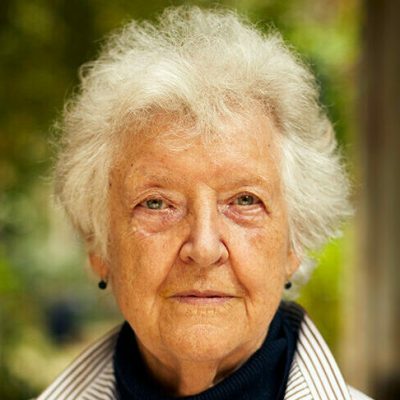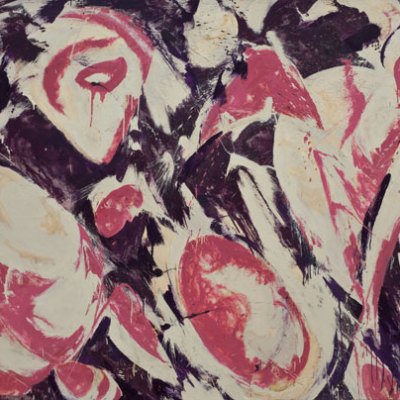From the October 2022 issue of Apollo. Preview and subscribe here.
In February 2020, Relief avec deux collines (‘Relief with Two Hills’) by the Polish sculptor Magdalena Abakanowicz (1930–2017), a powerful textile work of 1972 made from sisal, sold at Sotheby’s London for £52,500 with premium. On the face of it, this is not a spectacular result – the estimate had been £50,000–£70,000, in line with a previous result at the Polish auction house Polswiss Art, in December 2016, when her dramatic Abakan Rouge III (1971) achieved €74,082 on an estimate of €43,000–€57,000. And the figure does not approach the record €2.9m paid at Polswiss Art in December 2021 for Abakanowicz’s installation Bambini – these 83 haunting headless figures, made from concrete, wood and resin between 1998 and 1999, made a record price for an artwork in Poland. For Emma Baker, head of Sotheby’s contemporary art evening sale in London, however, the Sotheby’s result ‘is an indication something is happening in her market’. The previous highest price at Sotheby’s for an Abakanowicz textile was $20,000 for Cercle Clair (1971), in New York in 2008. At Christie’s London later in 2020, another 1971 work, Brun, fetched £55,000 (est. £18,000–£25,000). On the eve of Tate Modern’s major presentation of Abakanowicz’s Abakans from the 1960s and 1970s – a series of free hanging, three-dimensional textile sculptures – which opens in November, these results suggest that market recognition for the artist’s textile work is catching up with the fame of her figurative sculpture.
Abakanowicz is just one of a group of female artists – mostly from Europe and North America, but including Olga de Amaral from Colombia – whose textile work, initially foxing to critics and collectors alike, has come to be understood as fine art. In 2010 Abakanowicz explained in an interview: ‘The Abakans irritated people. They came at the wrong time.’ In fabric, she explained, French tapestry was still dominant; the contemporary art world was focused on Pop and conceptual art.
Women artists in the 20th century turned to textile for a variety of reasons. At the supposedly progressive Bauhaus in the 1920s, women, including Anni Albers, were directed to the textile department, away from architecture or painting. There, in the hands of Gunta Stölzl, Albers and Marli Ehrman, among others, textile became a primary artistic medium. When forced by the rise of Nazism to relocate to the United States, Albers and Ehrman inspired new communities of female artists, at, respectively, Black Mountain College in North Carolina and László Moholy-Nagy’s New Bauhaus in Chicago.
By contrast, in post-war Soviet Eastern Europe – including Poland – while male painters and sculptors were required to conform to the dictates of Socialist Realism, women at art school, compelled to study textile design and weaving, found greater creative freedom. After an early show of paintings was closed down, Abakanowicz was offered a place to work in the studio of the weaver Maria Laszkiewicz, who eventually encouraged her to exhibit her groundbreaking work at the first International Tapestry Biennale in Lausanne in 1962. Tom Grotta and Rhonda Brown of Browngrotta Arts, long-term dealers in textile art, will open a new show on 8 October, ‘Allies for Art: Work from NATO-related countries’, highlighting works from Eastern and Western Europe from the 1960s to the present, created under or influenced by political uncertainty. They say, ‘Several of the other artists in the exhibition from Eastern Europe, including Jolanta Owidzka, Zofia Butrymowicz, Anna Urbanowicz-Krowacka and Krystyna Wojtyna-Drouet of Poland and Luba Krejci and Jan Hladik of Czechoslovakia, were introduced to US audiences from the 1960s through the 1980s by Chicago gallerists Jacques and Anne Baruch, who spirited their work out of countries under oppressive regimes.’ They quote Anne Baruch’s admiring appraisal: ‘Though there were […] shortages of studios, materials, and most necessities for daily life, all their problems did not hamper their work. Rather, it stimulated their creativity, and their use of sisal, rope, metal, horsehair, and fleece as well as the traditional wool, flax and silk, revealed new artistic thought with results which were dynamic, highly personal and original.’ Brown adds, ‘The colours are warm, with a density of saturation that ties in with mid-century modernism.’
These artists joined the strong fibre art movement then developing in the United States, which included pioneering figures such as Claire Zeisler (1903–91) and Lenore Tawney (1907–2007). Meanwhile, Olga de Amaral (b. 1932), who lives and works in Bogotá, studied fibre art from 1954–55 at the Cranbrook Academy of Art in Michigan, founded in the 1920s under the direction of the Finnish architect Eliel Saarinen and his wife Loja Saarinen, a textile designer. By contrast, Sheila Hicks (b. 1934), for whom textile has also been a primary medium, studied under the artist Josef Albers at Yale University.
In many ways, however, it was the success of the fibre art movement that limited curatorial and market appreciation of these works as fine art. During the 1960s, ’70s and ’80s, work was collected and understood as fibre art. A major exhibition in 1969, ‘Wall Hangings’, at the Museum of Modern Art in New York, made prominent display of many of these artists’s works, but in a context where most, including Abakanowicz’s Yellow Abakan (1967–68), had been acquired for the design department.
In the 1980s, however, the market focused on fibre declined: ‘People were into shiny surfaces and hard materials,’ Grotta says. A group of contemporary conceptual artists who engaged with stitch, knitting, fabric and textile began to attract attention. Louise Bourgeois (1911–2010), who came from a family of tapestry restorers, Rosemarie Trockel (b. 1952) and Tracey Emin (b. 1963) are among a number of women artists for whom textile – and its association with the feminist dialogues of the 1980s – became important.
Mad Tracey from Margate. Everyoneʼs Been There (1997), Tracey Emin

Currently, it is these artists whose works are mostly highly valued. The record work at auction for Trockel is Untitled (1985–88), which achieved just under $5m at Sotheby’s New York on 14 May 2014. This also represents a record for a textile at auction. Tracey Emin’s second most highly valued work at auction after My Bed is the appliquéd quilt Mad Tracey from Margate. Everyone’s Been There (1997) sold in 2014 at Christie’s London for £722,500 (est. £700,000–£1m). By contrast, Anni Albers’s record stands at $104,500, for Untitled, sold at Christie’s New York in 2009, and Sheila Hicks’s at $125,000, for Untitled (1975), sold at Los Angeles Modern Auctions in 2016. The disintegration for both artists and audiences of distinctions of value between disciplines, genres and media has led to a revaluation. Tate’s Anni Albers exhibition in 2018, the Hepworth Wakefield’s recent show ‘Sheila Hicks: Off Grid’ and the exhibition ‘Olga de Amaral: To Weave a Rock’, which toured from the Museum of Fine Arts Houston to Cranbrook Art Museum in 2021, have all brought serious institutional attention to the field. Tessa Lord, a specialist and head of the post-war contemporary art evening auction at Christie’s London, says, ‘These retrospective exhibitions give audiences an opportunity to explore an entire oeuvre, and help to expand the collector base.’ Emma Baker at Sotheby’s suggests that these exhibitions have enabled a ‘rediscovery of aspects of art history’. ‘Sheila Hicks, for instance, is a smart person to collect,’ she adds. ‘I feel her work is undervalued. She is an important voice in the 20th-century abstract dialogue.’
Strata XV (2009), Olga de Amaral. Courtesy Lisson Gallery; © Olga de Amaral

The prices of Olga de Amaral in particular have risen strongly since 2014. According to Kaeli Deane of Lisson Gallery, which opened a solo show of de Amaral in September, ‘It started with the secondary market, where at auction she had a number of strong results, mostly for large-scale gold leaf-covered tapestries. These covetable pieces have historically been her most recognisable work.’ Over the past year or so, however, ‘We have seen a newly invigorated appreciation for Olga’s earlier work from the 1960s, ’70s and ’80s, much of which contains no gold at all and instead consists of subtle organic materials such as horsehair and wool.’ She credits, too, a strong push from curators to re-examine fibre art and craft for helping to bring her work to the forefront of the art market. Deane notes, particularly, ‘tremendous demand for the two exhibitions we hosted last year in East Hampton and New York, coming from collectors all over the world, many of whom had not collected fibre art previously’.
From the October 2022 issue of Apollo. Preview and subscribe here.



